An Interleaved Phase-Shift Full-Bridge Converter with Dynamic Dead Time Control for Server Power Applications
Abstract
1. Introduction
2. System Description
- (1)
- The magnetizing inductance Lm and the output inductors Lo are large enough to be considered as a constant current source during the dead time of the primary switches.
- (2)
- Resonances by parasitic components are ignored, except for Phase 1 resonance between Lk1 and the parasitic capacitor of Q1–Q4 and Phase 2 resonance Lk2 and the parasitic capacitor of Q5–Q8.
- (3)
- The turns ratio of the coupled inductor is 1:1, and it has a high coupled coefficient.
3. Dynamic Dead Time Control
4. Computer Simulations and Experimental Results
5. Conclusions
Author Contributions
Funding
Conflicts of Interest
References
- Yadav, G.N.B.; Narasammaand, N.L. An active soft switched phaseshifted full-bridge DC–DC converter: Analysis, modeling, design, and implementation. IEEE Trans. Power Electron. 2014, 29, 4538–4550. [Google Scholar] [CrossRef]
- Cho, J.H.; Seong, H.W.; Jung, S.M.; Park, J.S.; Moon, G.W.; Youn, M.J. Implementation of digitally controlled phase shift full bridge converter for server power supply. In Proceedings of the 2010 IEEE Energy Conversion Congress and Exposition, Atlanta, GA, USA, 12–16 September 2010; pp. 802–809. [Google Scholar]
- Cho, S.Y.; Kim, J.K.; Lee, I.W.; Kim, M.Y.; Moon, G.W. High efficiency standby forward converter integrated with DC/DC phase-shift full bridge converter for server power supply system. In Proceedings of the 8th International Conference on Power Electronics—ECCE Asia, Jeju, Korea, 30 May–3 June 2011; pp. 1169–1176. [Google Scholar]
- Lee, S.-H.; Park, C.-Y.; Kwon, J.-M.; Kwon, B.-H. Hybrid-Type fullbridge DC/DC converter with high efficiency. IEEE Trans. Power Electron. 2015, 30, 4156–4164. [Google Scholar] [CrossRef]
- Wu, H.; Zhang, J.; Qin, X.; Mu, T.; Xing, Y. Secondary-Side-Regulated soft-switching full-bridge three-port converter based on bridgeless boost rectifier and bidirectional converter for multiple energy interface. IEEE Trans. Power Electron. 2016, 31, 4847–4860. [Google Scholar] [CrossRef]
- Li, H.; Zhao, L.; Xu, C.; Zheng, X. A dual half-bridge phase-shifted converter with wide ZVZCS switching range. IEEE Trans. Power Electron. 2018, 33, 2976–2985. [Google Scholar] [CrossRef]
- Kanamarlapudi, V.R.K.; Wang, B.; So, P.L.; Wang, Z. Analysis, design, and implementation of an APWM ZVZCS full-bridge DC–DC converter for battery charging in electric vehicles. IEEE Trans. Power Electron. 2017, 32, 6145–6160. [Google Scholar] [CrossRef]
- Kim, Y.-D.; Lee, I.-O.; Cho, I.-H.; Moon, G.-W. Hybrid dual fullbridge DC–DC converter with reduced circulating current, output filter, and conduction loss of rectifier stage for RF power generator application. IEEE Trans. Power Electron. 2014, 29, 1069–1081. [Google Scholar]
- Shih, L.-C.; Liu, Y.-H.; Chiu, H.-J. A novel hybrid mode control for phase-shift full bridge converter featuring high efficiency over full load range. IEEE Trans. Power Electron. 2019, 34, 2794–2804. [Google Scholar] [CrossRef]
- Kim, D.-Y.; Kim, C.-E.; Moon, G.-W. Variable dead time method in the phase-shifted full-bridge converter for reduced power consumption under light load conditions. IEEE Trans. Power Electron. 2013, 28, 5120–5127. [Google Scholar] [CrossRef]
- Kim, J.-W.; Kim, D.-Y.; Kim, C.-E.; Moon, G.-W. A simple switching control technique for improving light load efficiency in a phase-shifted full-bridge converter with a server power system. IEEE Trans. Power Electron. 2014, 29, 1562–1566. [Google Scholar] [CrossRef]
- Joo, D.M.; Lee, B.K.; Kim, J.S. Dead-time optimisation for a phaseshifted DC–DC full bridge converter with GaN HEMT. IET Electron. Lett. 2016, 52, 769–770. [Google Scholar] [CrossRef]
- Yu, W.; Lai, J.-S.; Lai, W.-H.; Wan, H. Hybrid resonant and PWM converter with high efficiency and full soft-switching range. IEEE Trans. Power Electron. 2012, 27, 4925–4933. [Google Scholar] [CrossRef]
- Lee, I.-O.; Moon, G.-W. Soft-Switching DC/DC converter with a full ZVS range and reduced output filter for high-voltage applications. IEEE Trans. Power Electron. 2013, 28, 112–122. [Google Scholar] [CrossRef]
- Lee, I.-O.; Moon, G.-W. Phase-shifted PWM converter with a wide ZVS range and reduced circulating current. IEEE Trans. Power Electron. 2013, 28, 908–919. [Google Scholar] [CrossRef]
- Safaee, A.; Jain, P.; Bakhshai, A. A ZVS pulsewidth modulation fullbridge converter with a low-RMS-current resonant auxiliary circuit. IEEE Trans. Power Electron. 2016, 31, 4031–4047. [Google Scholar] [CrossRef]
- Zhao, L.; Li, H.; Wu, X.; Zhang, J. An improved phase-shifted fullbridge converter with wide-range ZVS and reduced filter requirement. IEEE Trans. Ind. Electron. 2018, 65, 2167–2176. [Google Scholar] [CrossRef]
- Park, K.-B.; Kim, C.-E.; Moon, G.-W.; Youn, M.-J. Voltage oscillation reduction technique for phase-shift full-bridge converter. IEEE Trans. Ind. Electron. 2007, 54, 2779–2790. [Google Scholar] [CrossRef]
- Miftakhutdinov, R. New aspects on analyzing ZVS conditions for converters using super-junction Si and wide bandgap SiC and GaN power FETs. In Proceedings of the 2014 16th European Conference on Power Electronics and Applications, Lappeenranta, Finland, 26–28 August 2014; pp. 1–9. [Google Scholar]
- Kasper, M.; Burkart, R.M.; Deboy, G.; Kolar, J.N. ZVS of power MOSFETs revisited. IEEE Trans. Power Electron. 2016, 31, 8063–8067. [Google Scholar] [CrossRef]
- Tran, D.D.; Vu, H.N.; Yu, S.; Choi, W. A Novel soft-switching full-bridge converter with a combination of a secondary switch and a nondissipative snubber. IEEE Trans. Power Electron. 2018, 33, 1440–1452. [Google Scholar] [CrossRef]
- Kishore, K.V.R.; Wang, B.F.; Kumar, K.N.; So, P.L. A new ZVS full-bridge DC-DC converter for battery charging with reduced losses over full-load range. IEEE Trans. Ind. Appl. 2018, 54, 571–579. [Google Scholar]
- Shen, Y.; Zhao, W.; Chen, Z.; Cai, C. Full-bridge LLC resonant converter with series-parallel connected transformers for electric vehicle onboard charger. IEEE Access. 2018, 6, 13490–13500. [Google Scholar] [CrossRef]
- Gu, B.; Lai, J.-S.; Kees, N.; Zheng, C. Hybrid-switching fullbridge dc-dc converter with minimal voltage stress of bridge rectifier, reduced circulating losses, and filter requirement for electric vehicle battery chargers. IEEE Trans. Power Electron. 2013, 28, 1132–1144. [Google Scholar] [CrossRef]
- Redl, R.; Sokal, N.O.; Balogh, L. A novel soft-switching full-bridge DC/DC converter: Analysis design considerations and experimental results at 1.5 kW, 100 kHz. IEEE Trans. Power Electron. 1991, 6, 408–418. [Google Scholar] [CrossRef]
- Kim, E.-S.; Kim, Y.-H. A ZVZCS PWM FB DC/DC converter using a modified energy-recovery snubber. IEEE Trans. Ind. Electron. 2002, 49, 1120–1127. [Google Scholar]
- ST Microelectronics AN5018. Calculation of Turn-Off Power Losses Generated by an Ultrafast Diode; STMicroelectronics: Geneva, Switzerland, 2017; pp. 1–20. Available online: https://www.st.com/resource/en/application_note/dm00380483-calculation-of-turnoff-power-losses-generated-by-a-ultrafast-diode-stmicroelectronics.pdf (accessed on 1 January 2021).
- Baliga, B.J. Fundamentals of Power Semiconductor Devices; Springer: New York, NY, USA, 2008. [Google Scholar]
- Erickson, R.W.; Maksimovic, D. Fundamentals of Power Electronics, 2nd ed.; Kluwer: Norwell, MA, USA, 2001. [Google Scholar]
- Ogale, A.; Sarlioglu, B.; Wang, Y. A Novel Design and Performance Characterization of a Very High Current Low Voltage DC-DC Converter for Application in Micro and Mild Hybrid Vehicles. In Proceedings of the IEEE Applied Power Electronics Conference and Exposition, Charlotte, NC, USA, 15–19 March 2015. [Google Scholar]
- Han, J.K.; Moon, G.W. High-Efficiency Phase-Shifted Full-Bridge Converter with a New Coupled Inductor Rectifier (CIR). IEEE Trans. Power Electron. 2019, 34, 8468–8480. [Google Scholar] [CrossRef]
- Zhang, M.T.; Jovanovic, M.M.; Lee, F.C. Analysis and evaluation of interleaving techniques in forward converters. IEEE Trans. Power Electron. 1998, 13, 690–698. [Google Scholar] [CrossRef]
- Wu, X.; Chen, H.; Zhang, J.; Peng, F.; Qian, Z. Interleaved phase-shift full-bridge converter with transformer winding series-parallel autoregulated (SPAR) current doubler rectifier. IEEE Trans. Power Electron. 2015, 30, 4864–4873. [Google Scholar] [CrossRef]
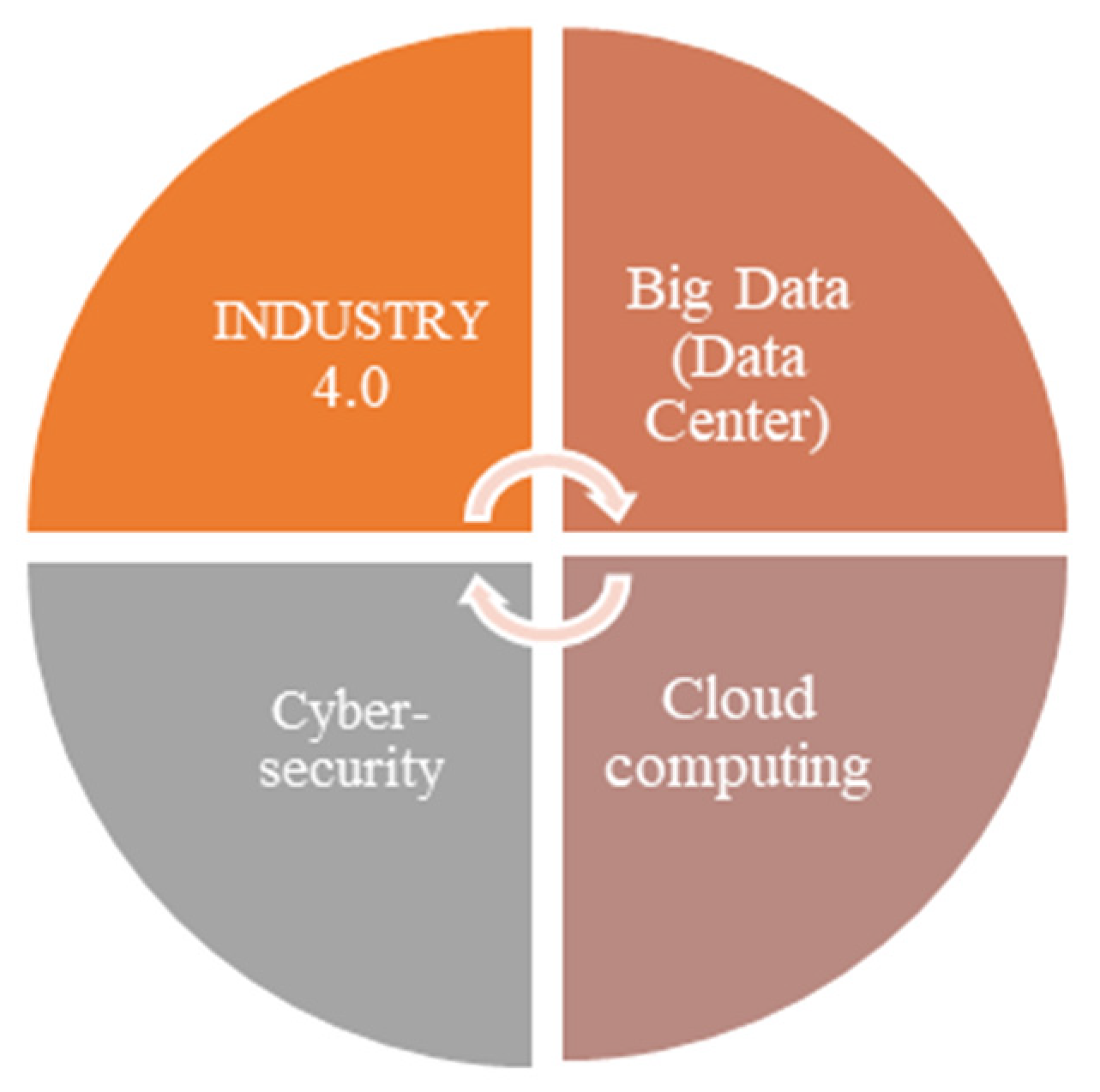
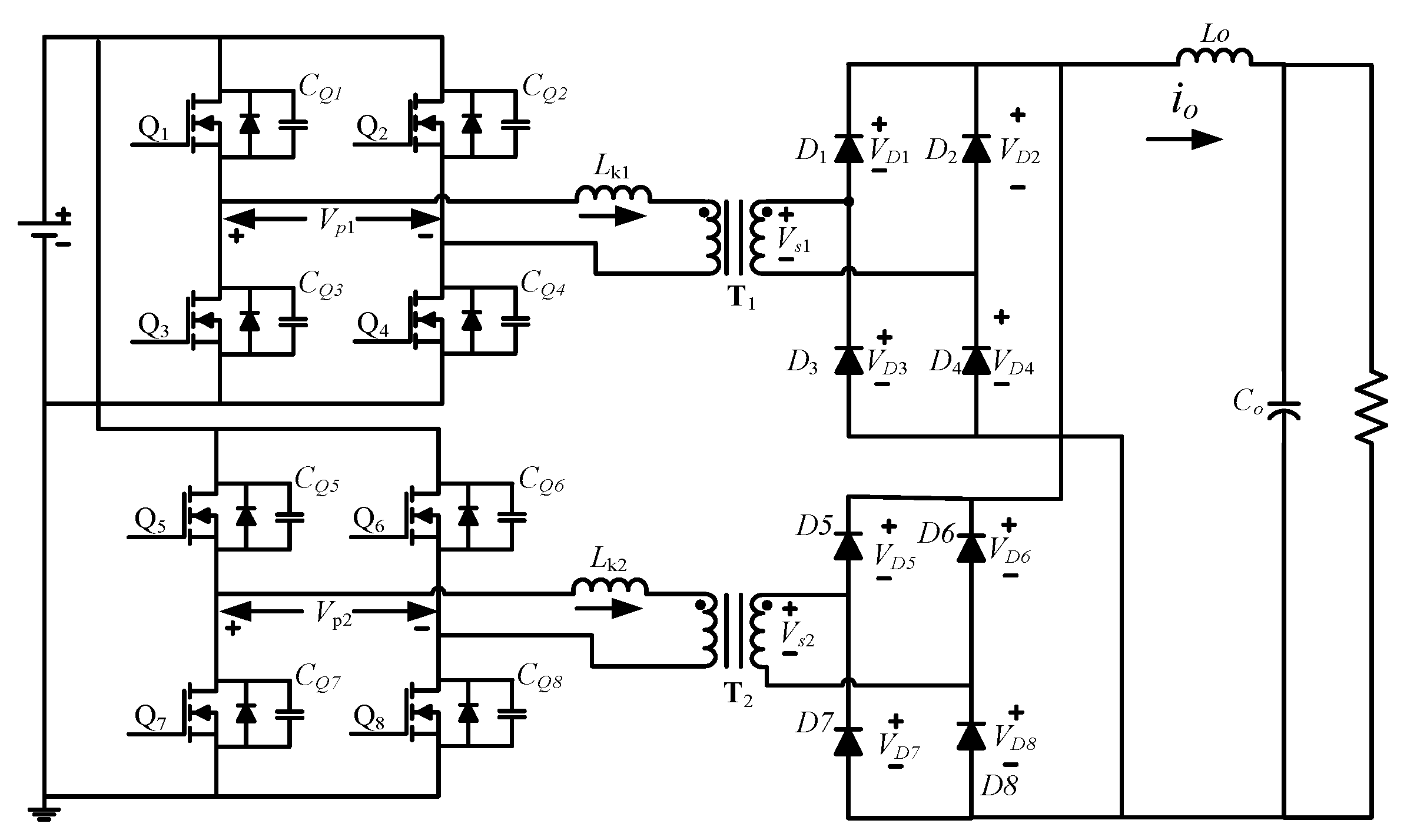
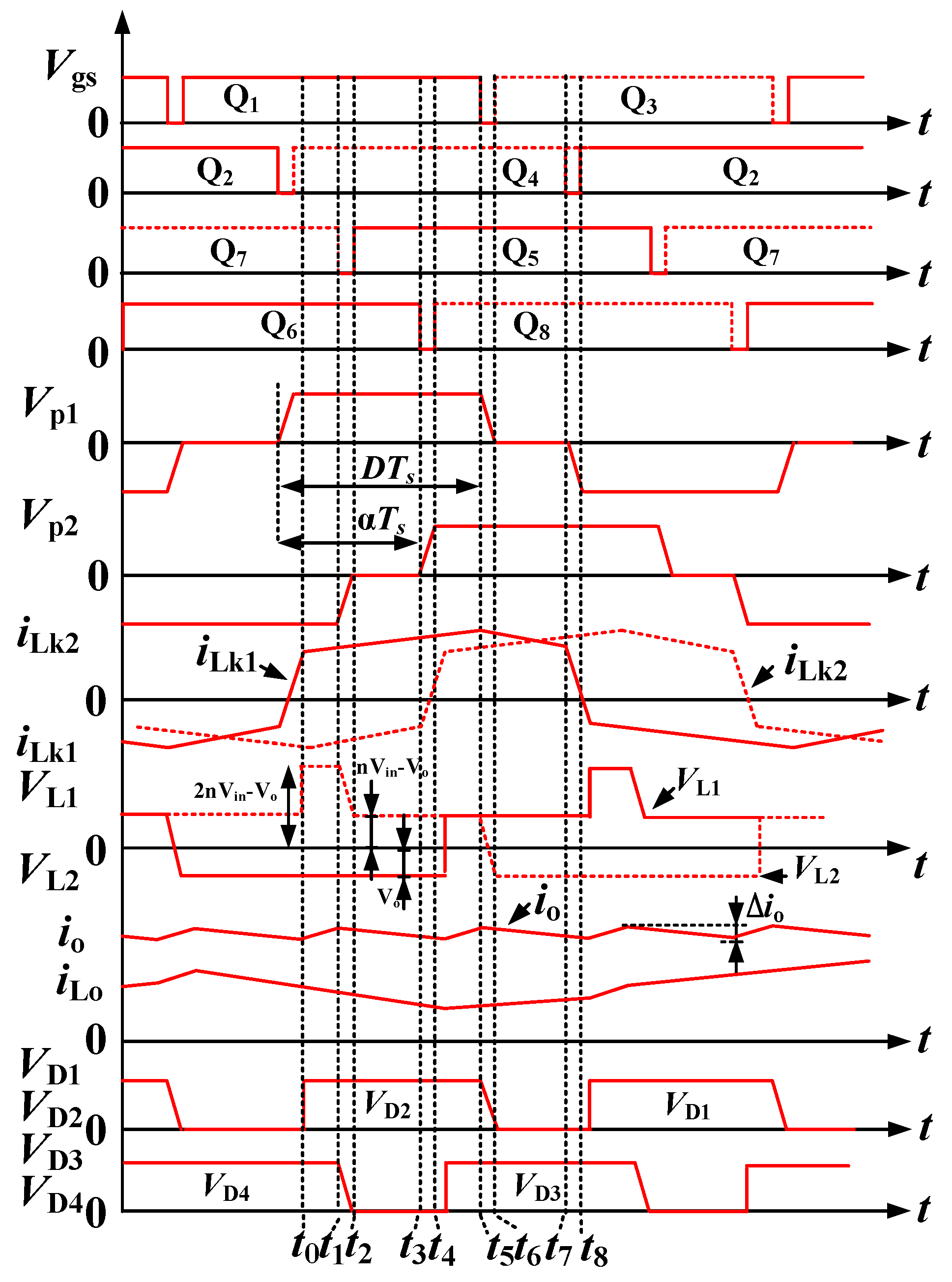
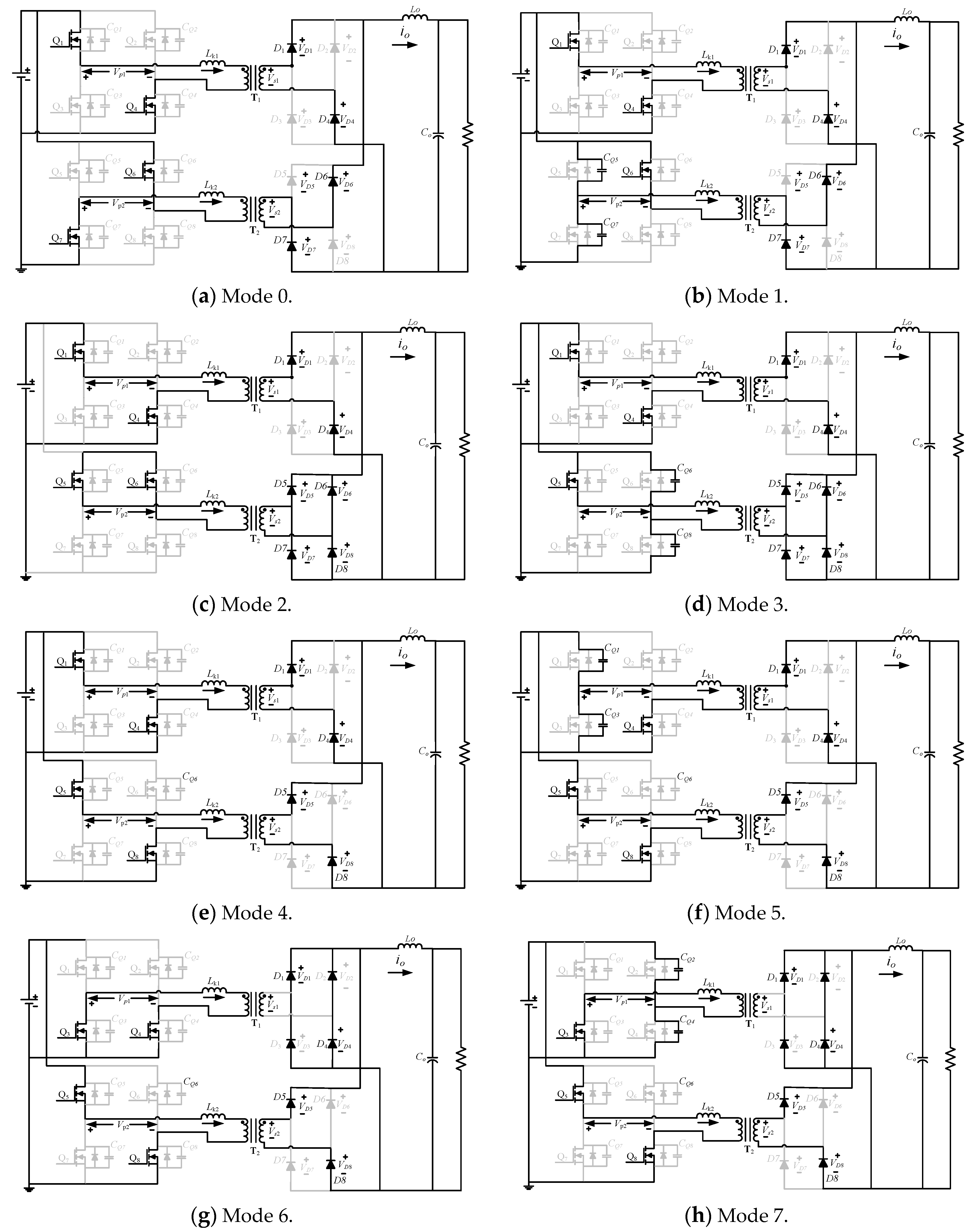
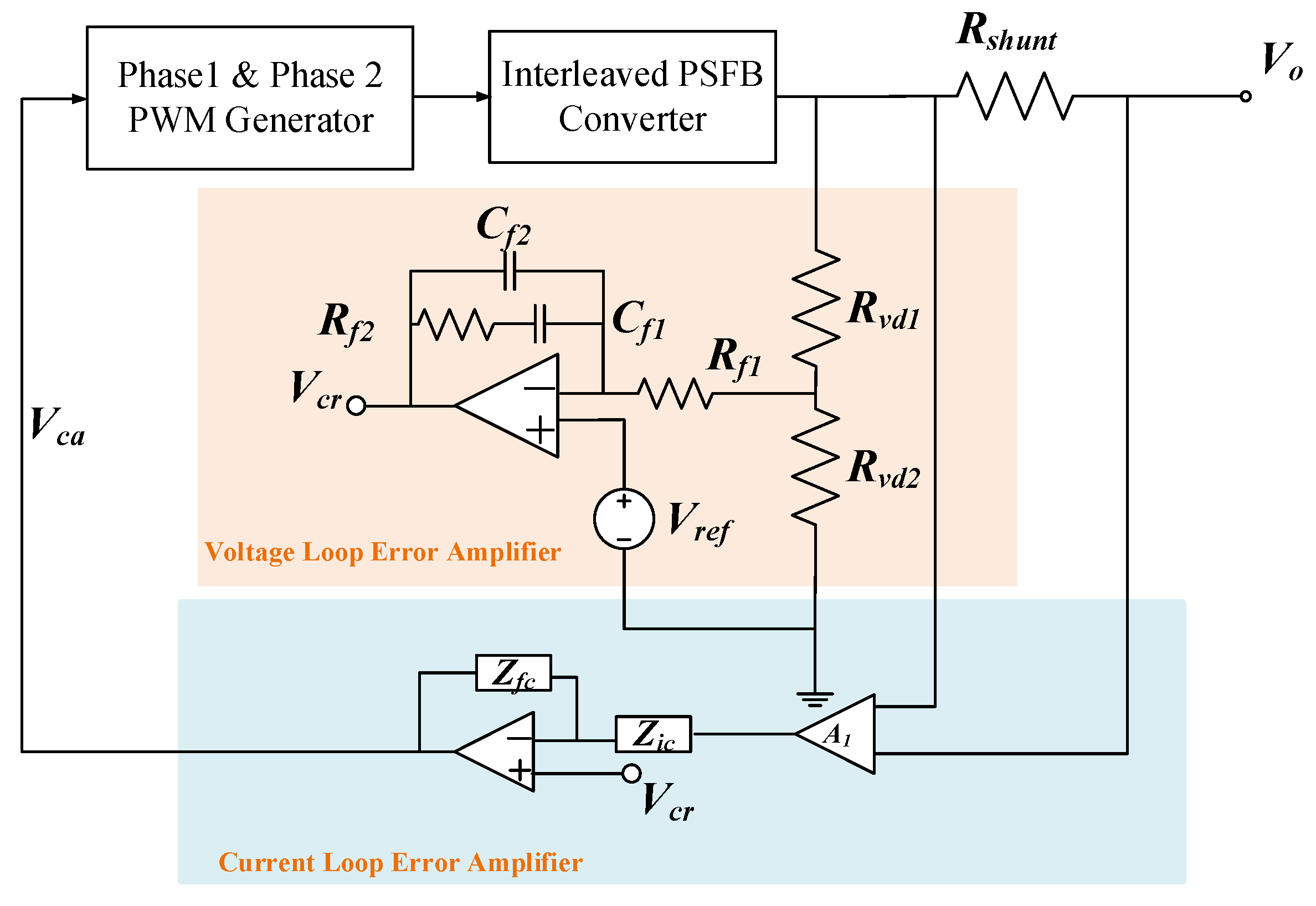
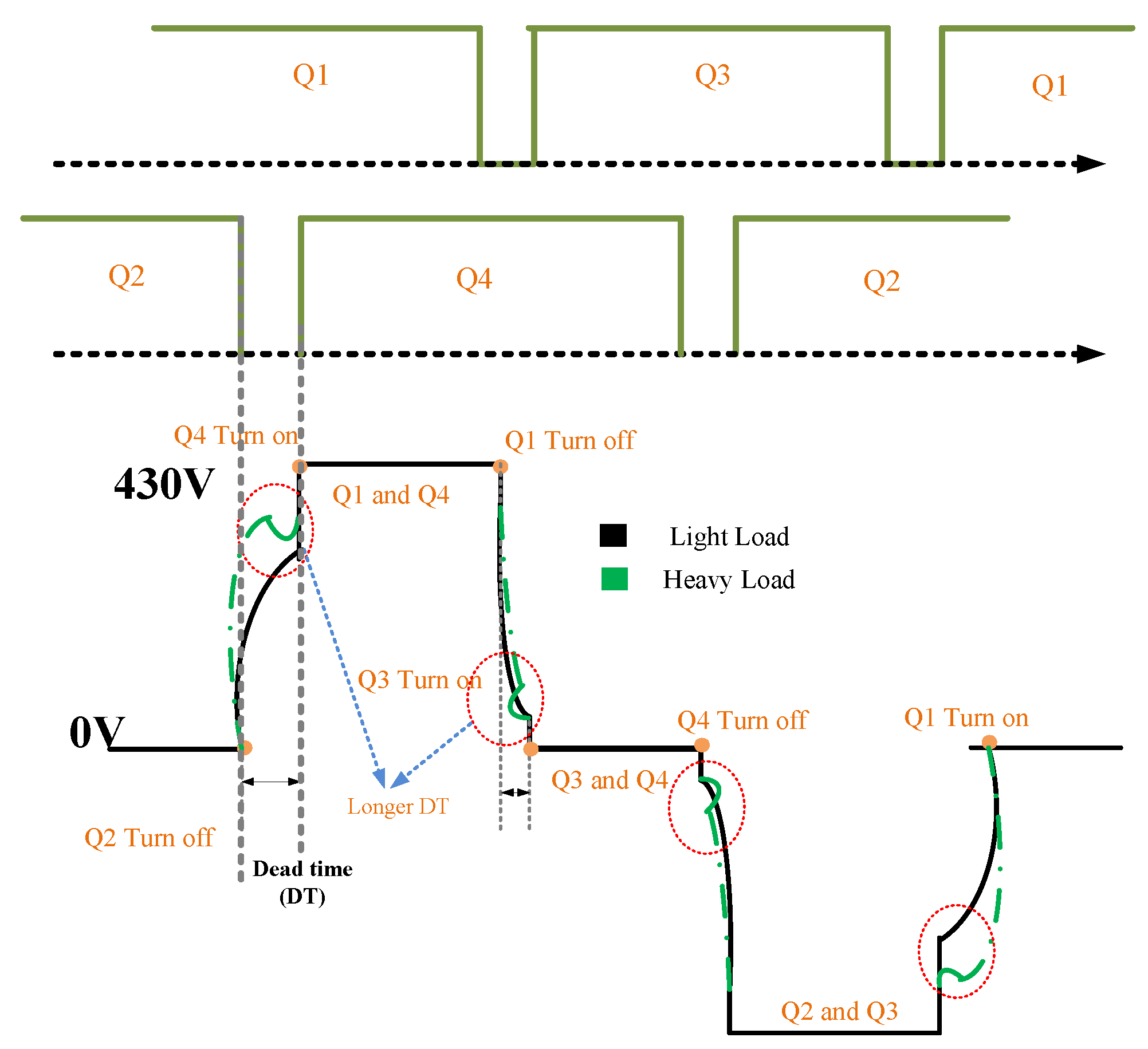

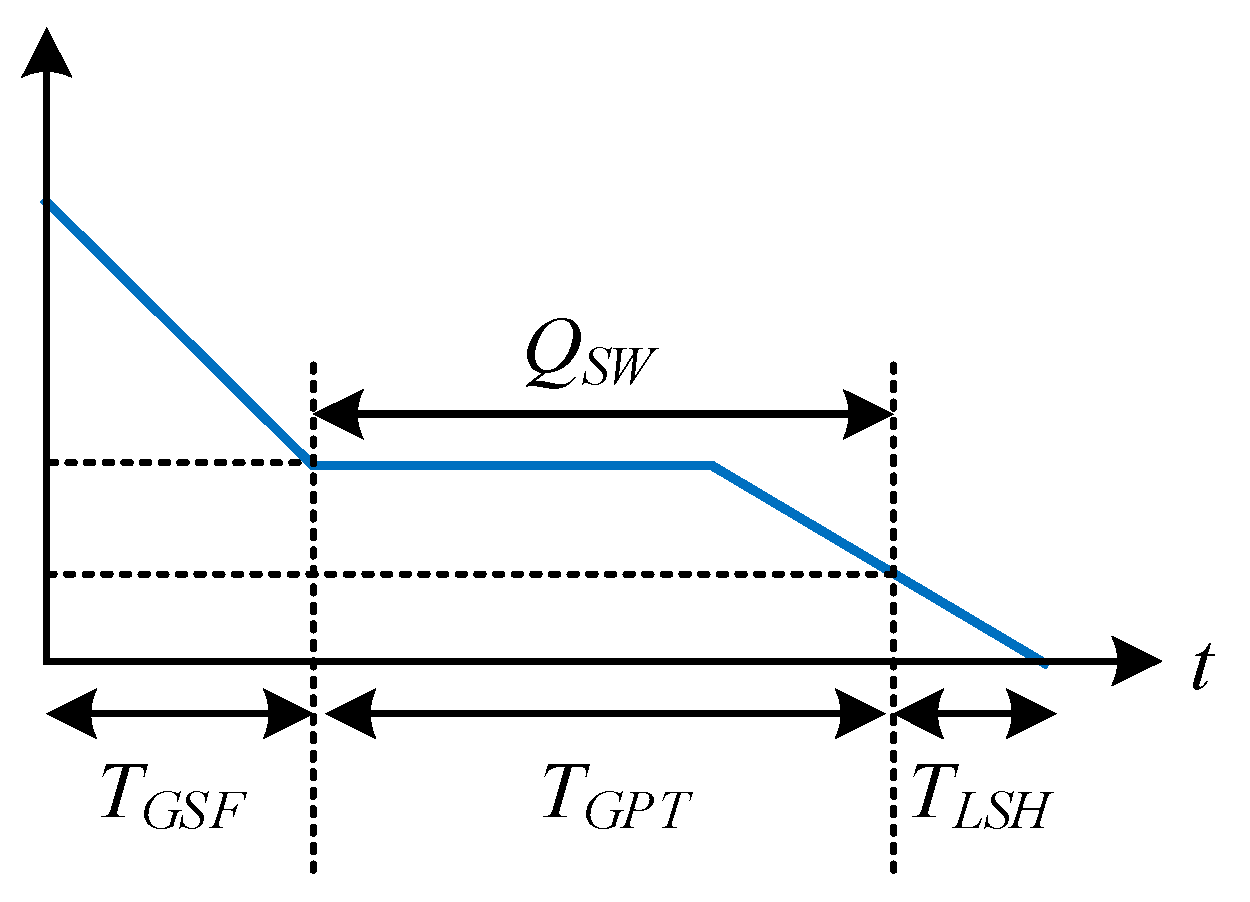
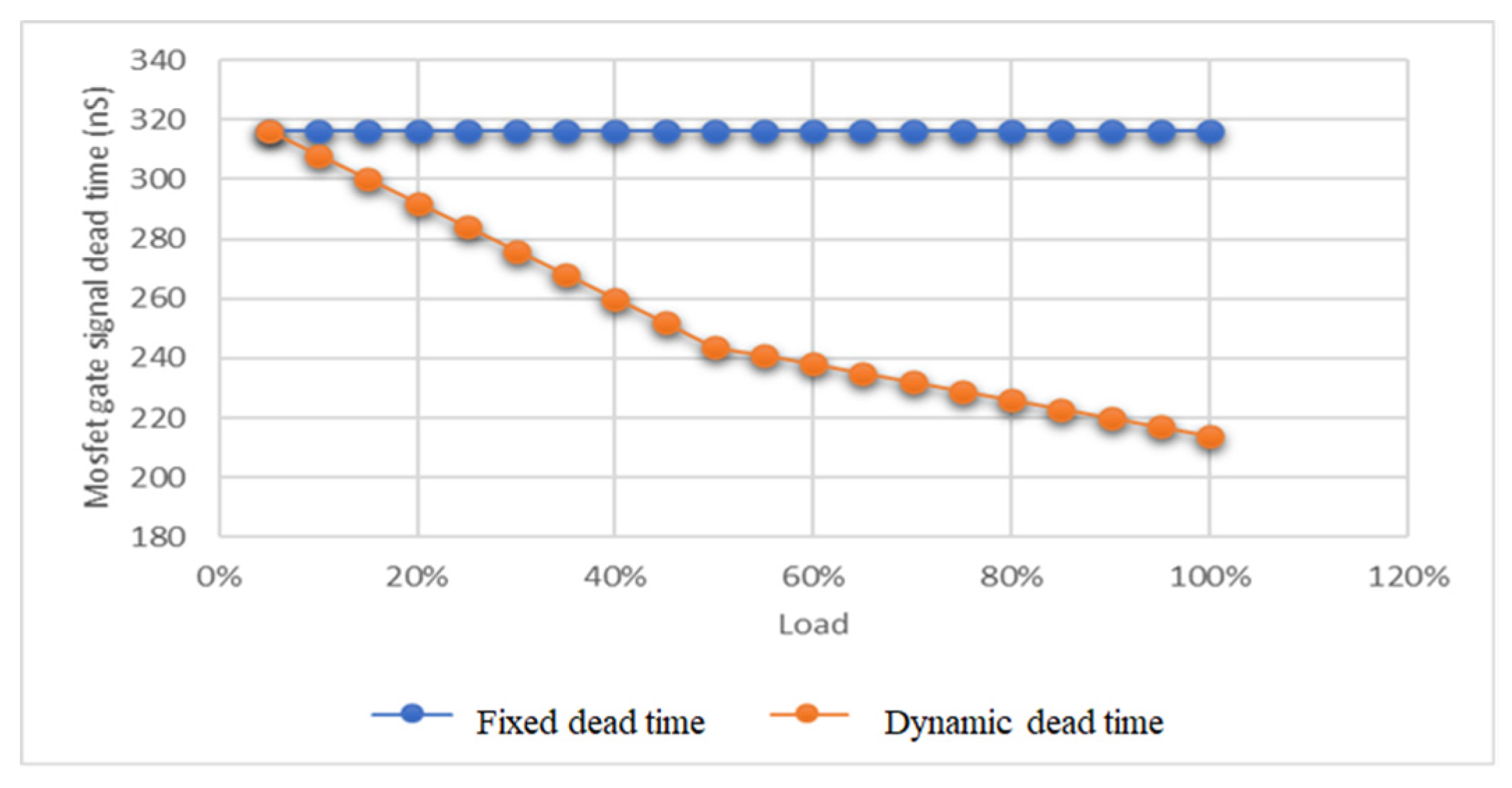
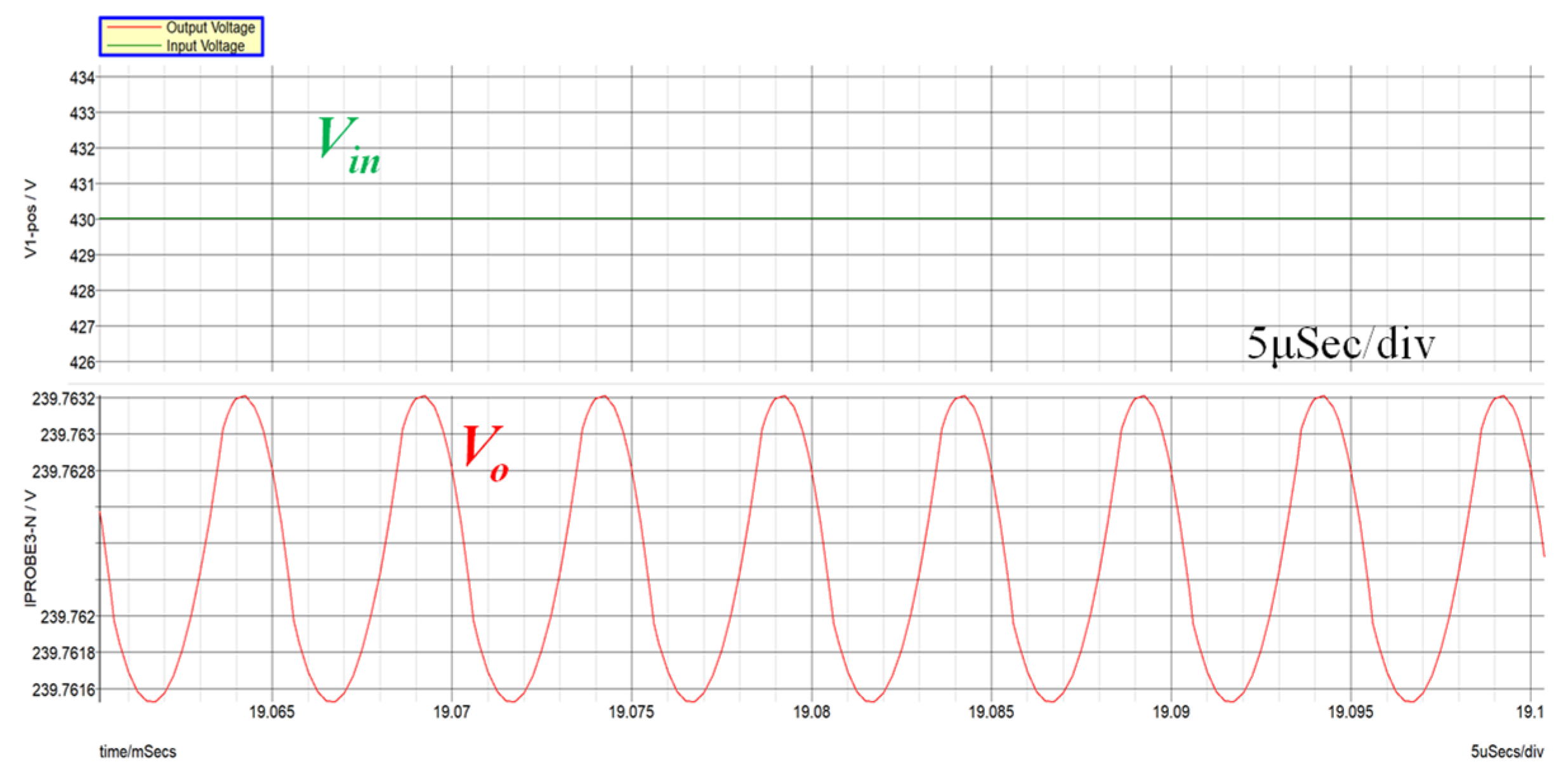
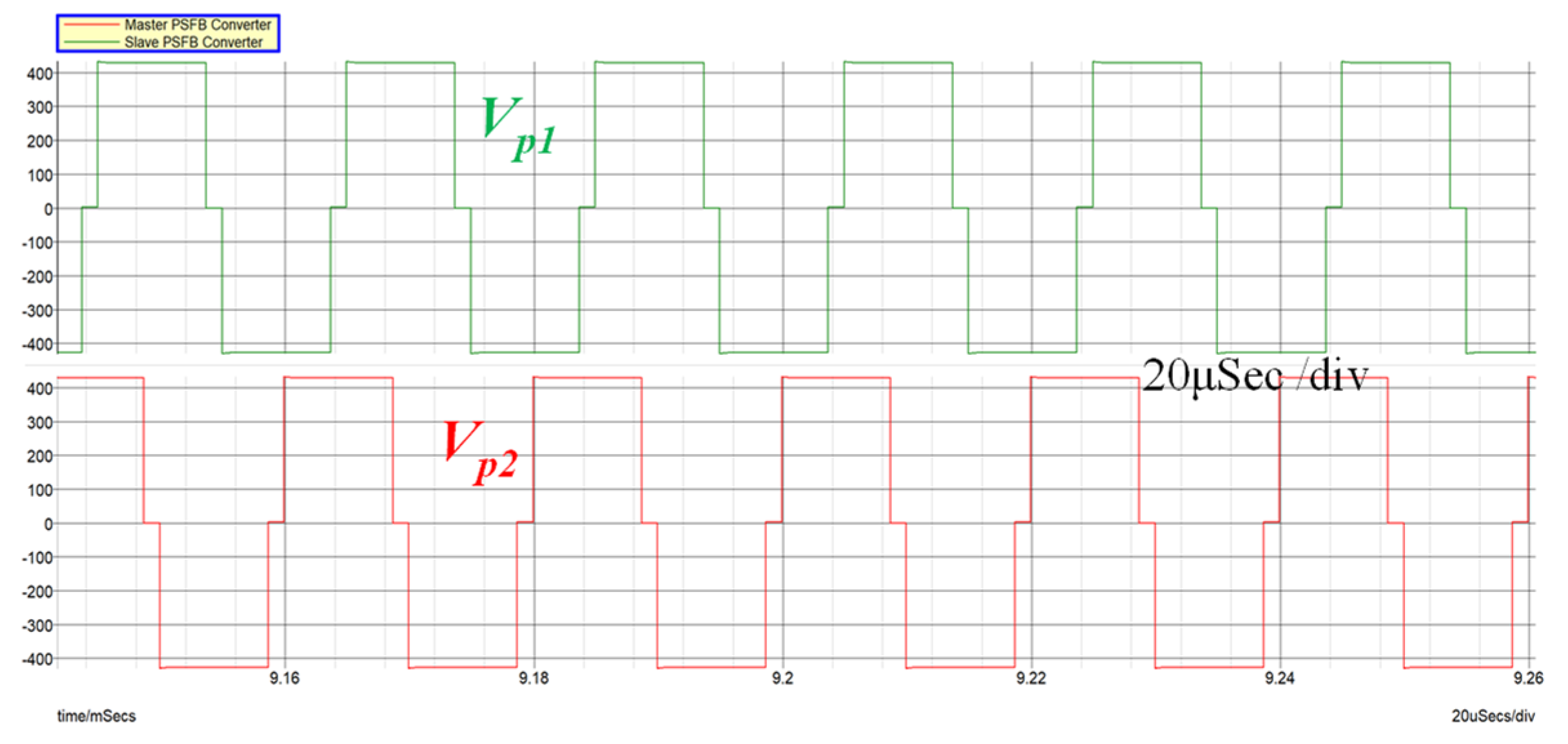

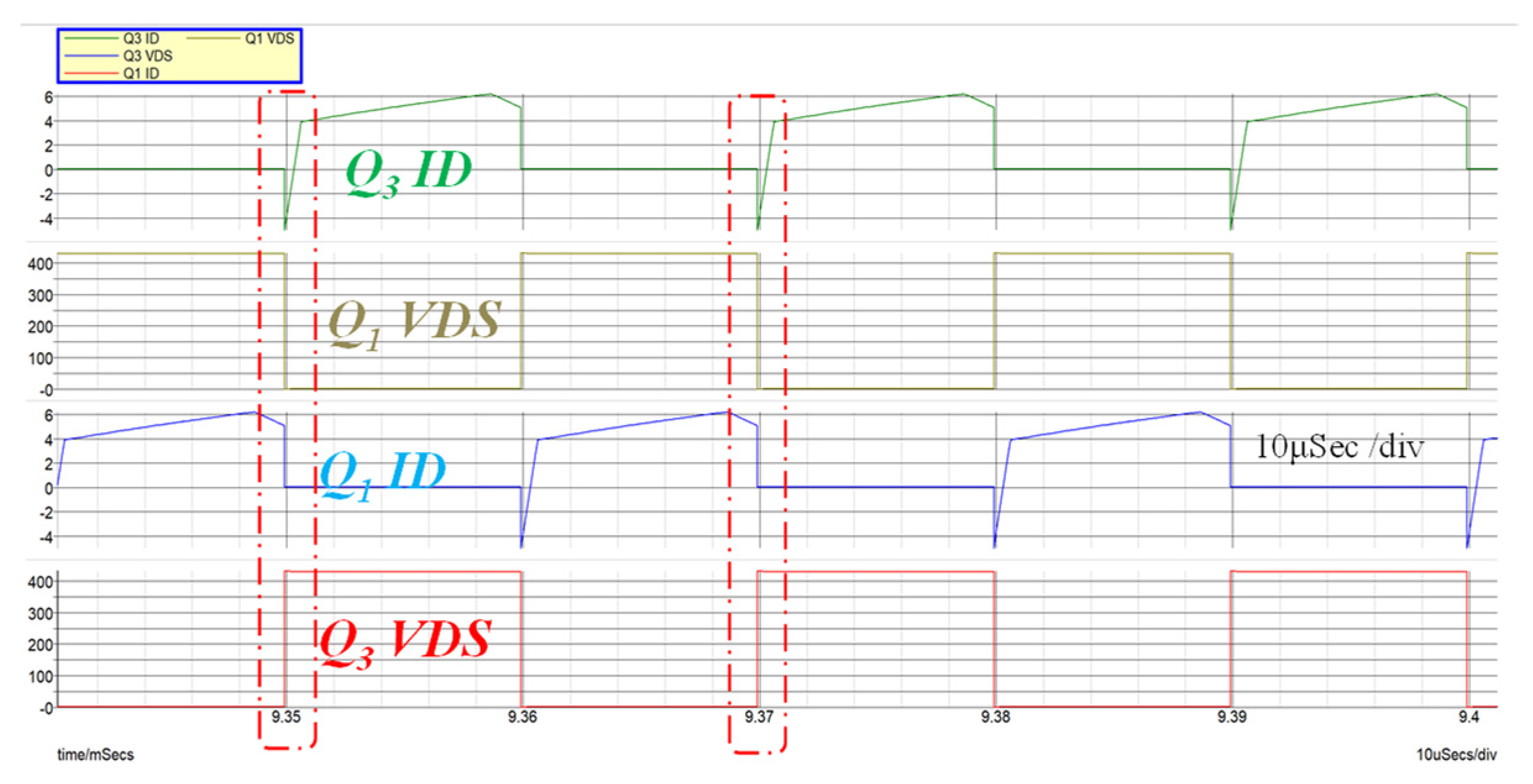




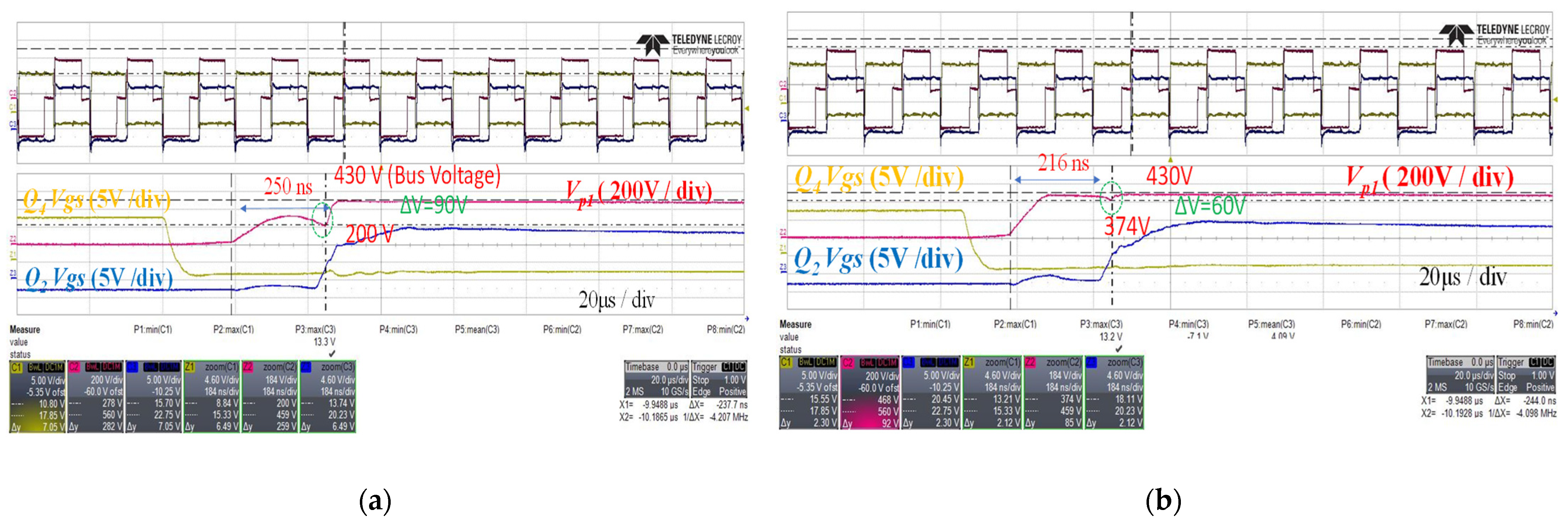
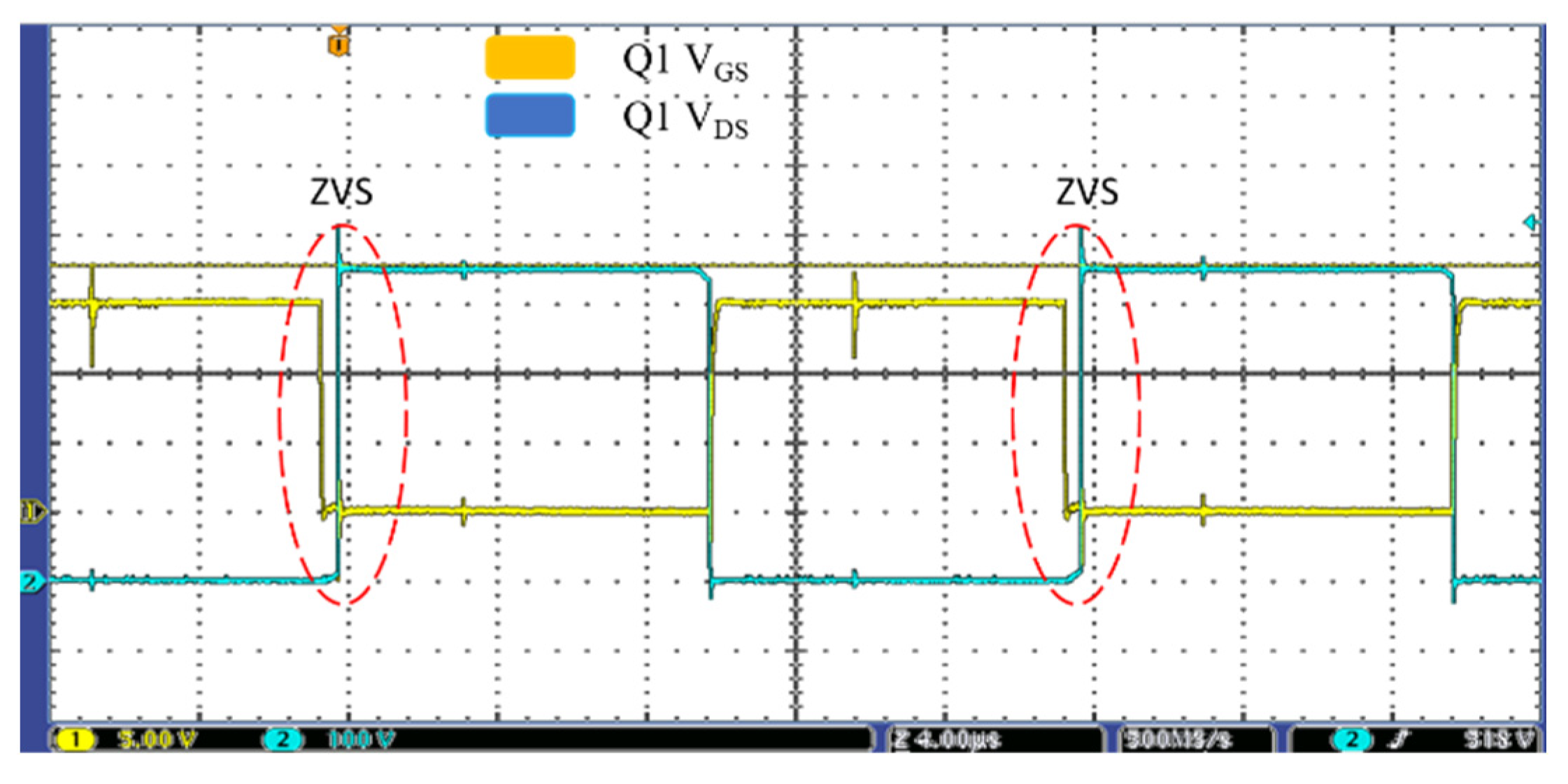
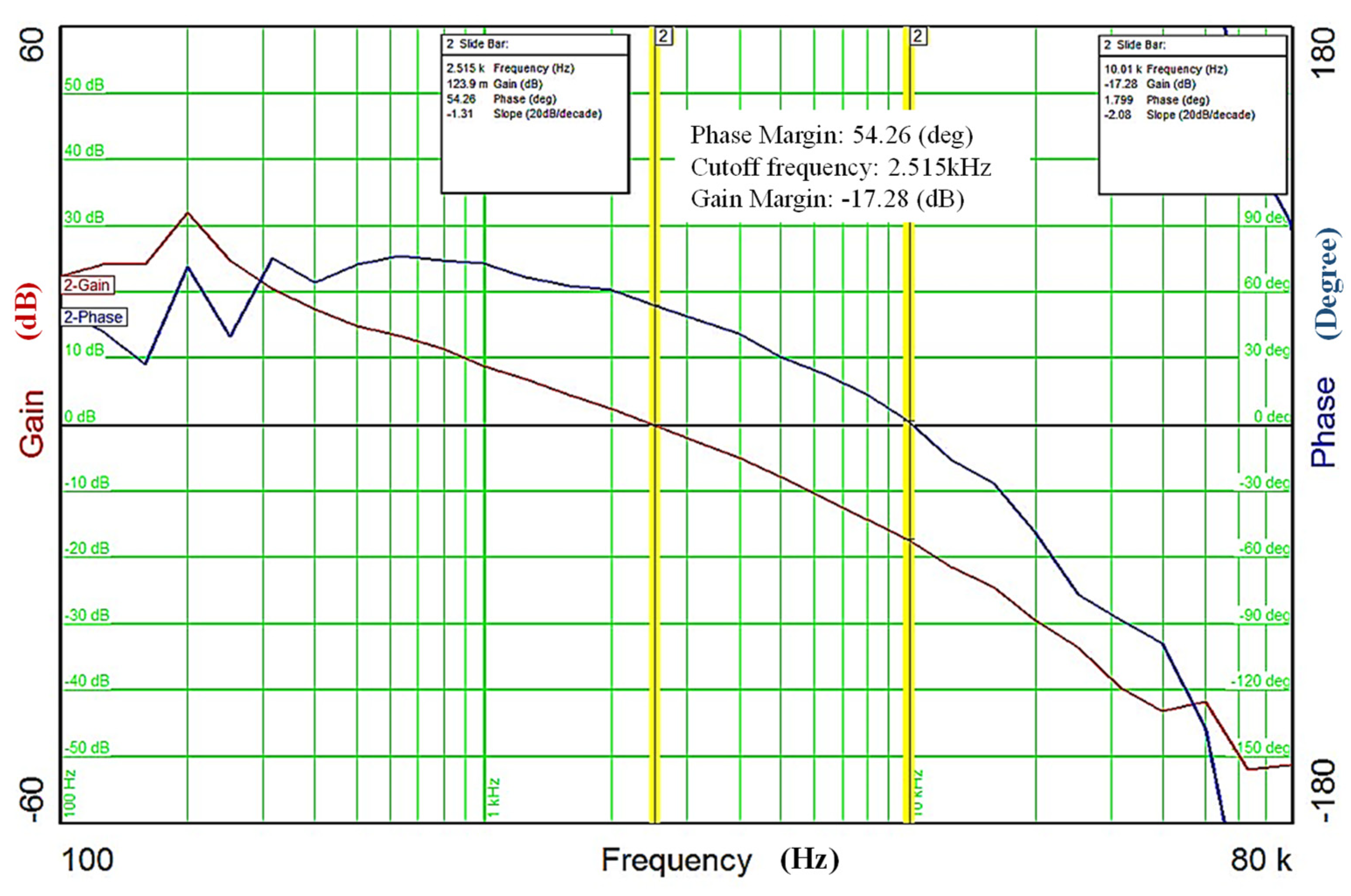

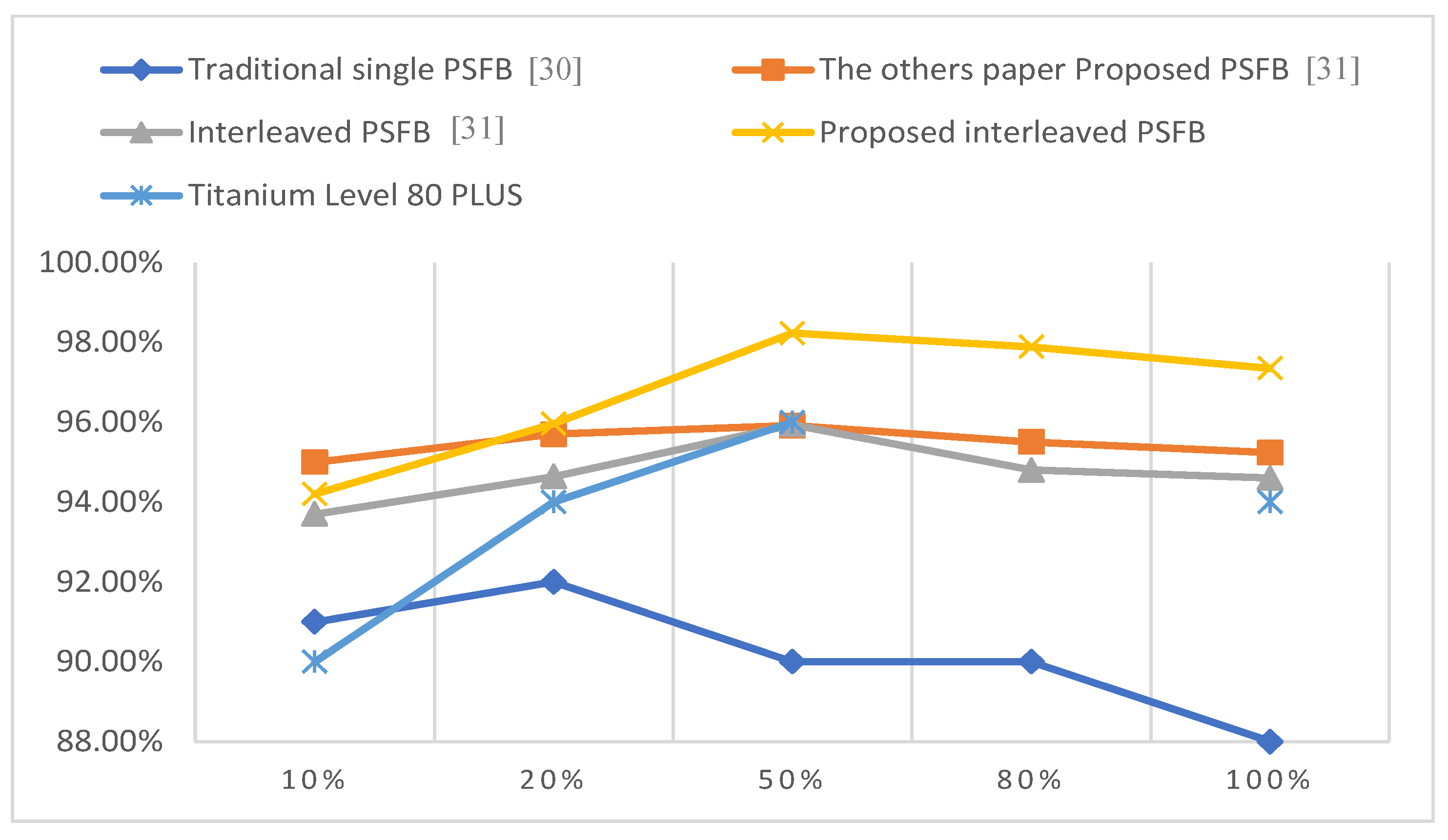
| Power rating | 3 kW |
| Input voltage, Vin | 390 VDC−450 VDC |
| Output voltage, Vout | 240 VDC ± 5V |
| Max. output current, Iomax | 12.5 A |
| Min. output current, Iomin | 0.05 A |
| Switching frequency, fs | 50 kHz |
| MOSFETs | IPP60R120C7 |
| Secondary Rectification Diode | STPSC10H065DI |
| Transformer Core | PQ3230 |
| Transformer turns radio | Np: Ns = 37:30 |
| Magnetizing inductance, Lm | 2.6 mH |
| Output inductance | 392 μH |
| Blocking capacitor | 1 μF |
| Diver IC | ADUM4223ARWZ-RL |
Publisher’s Note: MDPI stays neutral with regard to jurisdictional claims in published maps and institutional affiliations. |
© 2021 by the authors. Licensee MDPI, Basel, Switzerland. This article is an open access article distributed under the terms and conditions of the Creative Commons Attribution (CC BY) license (http://creativecommons.org/licenses/by/4.0/).
Share and Cite
Lee, J.-Y.; Chen, J.-H.; Lo, K.-Y. An Interleaved Phase-Shift Full-Bridge Converter with Dynamic Dead Time Control for Server Power Applications. Energies 2021, 14, 853. https://doi.org/10.3390/en14040853
Lee J-Y, Chen J-H, Lo K-Y. An Interleaved Phase-Shift Full-Bridge Converter with Dynamic Dead Time Control for Server Power Applications. Energies. 2021; 14(4):853. https://doi.org/10.3390/en14040853
Chicago/Turabian StyleLee, Jia-You, Jheng-Hung Chen, and Kuo-Yuan Lo. 2021. "An Interleaved Phase-Shift Full-Bridge Converter with Dynamic Dead Time Control for Server Power Applications" Energies 14, no. 4: 853. https://doi.org/10.3390/en14040853
APA StyleLee, J.-Y., Chen, J.-H., & Lo, K.-Y. (2021). An Interleaved Phase-Shift Full-Bridge Converter with Dynamic Dead Time Control for Server Power Applications. Energies, 14(4), 853. https://doi.org/10.3390/en14040853








